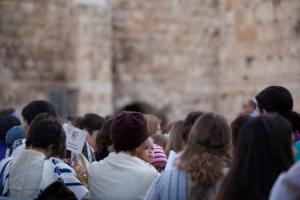This past February, we took 16 8th grade students from Congregation Beth Elohim on a trip to Israel. With little explanation of the politics, and in the context of aliyah l’regel, or religious pilgrimage, we took them to the Kotel to put notes in the wall and to pray. Our boys went with our tour guide Tzvi to the relatively empty large men’s section, and I took nine 13 and 14-year-old girls towards the crowded women’s section. At that very moment, three busloads of teen girls from an Ultra-Orthodox school came to the Kotel Plaza for mincha (afternoon prayers). With their prayer books in hand, girls in dark skirts streamed past our girls towards the wall, filling in all of the spaces between the women in chairs, swaying with silent fervor, leaning in with hand against the stone, tears running down some faces. Notes in hand, now standing behind a wall of uniformed daveners, our girls immediately retreated, and did not push towards the wall.
“Rabbi Shira, let’s go.”
As a Reform rabbi I find hope in the proposal put forth by Natan Sharansky allowing an option for egalitarian prayer at the Kotel/Kotel Plaza.
While I have been a member of the Women of the Wall for nearly 20 years, and did long-outdated academic work on their history and cause n 1997, my recent experience as congregational rabbi in Brooklyn highlights the salience of this compromise. While this week’s proposal does not allow women and mixed-gender groups to gather and pray aloud at the current plaza in front of the Western Wall, it will extend the plaza to the southern area near Robinson’s Arch, where egalitarian prayer will be allowed. Currently, that area is only accessible as an archaeological park, with entry fee.
At the Kotel, I urged my students to take a place at the wall, to put in a note. With long faces, the girls told me that it was crowded, and that they didn’t feel like they belonged here. I snaked my way up the wall, placed my arm through a small gap, and had each girl come next to me to reach over the girls and women who had front row places and to put in their notes. Feeling the disdainful looks from those around us, who made no move to let us in, we placed our notes and quickly retreated.
As we waited for the boys, the girls shared how they had waited for so long to see this place, and they got there to find that there was literally no room for them. They felt disconnected, disinherited, and dispirited. To add to the insult, the boys came back radiant, elated. They had been invited to join a mincha minyan, each had time and space in the wide and fairly empty plaza and had left their notes with prayers and singing.
I explained to Tzvi what our girls had said, and we immediately decided to change our plans and headed down to Robinson’s Arch, paying hundreds of shekels in entrance fees so that we could give them a different experience and perspective on this place to which we always turn in prayer. We looked at the steps, the two arching doorways now blocked in stones, the remains of mikvahs below us–and we prepared ourselves, with another narrative.
“This–this is the place that our ancestors came for their aliyah. It is at the bottom of these steps that our people stood, rich, poor, women, men, devout, doubting–this is where they prepared themselves to enter those doorways to go towards holiness. The temple was a place for all of us–and this is a holy place for all of us–no one Jew or group of Jews has a greater claim on the history or the holiness of this space than any other. We follow in the footsteps of our ancestors who stood in this very place ready to climb the stairs.”
Then, we silently ascended the stairs. Without a word, our students lined themselves as a group at this wall to the south, some put their hands on the wall, some sang quietly, prayed our shared ancient words in melodies and ways familiar to them. Some sat down and wrote new notes, and put them in the wall.
Was it the “Kotel?” No. But it was holy. And it was meaningful. And, in Rav Kook’s words, it enabled us to “renew the old and sanctify the new.”
While I recognize that, like all compromises, today’s includes concessions, I pray that it will be a win for a vibrant future of Jewish pluralism. I also hope that this compromise will allow the Kotel issue to recede from the limelight so that some of the other struggles for religious equality, that are more pressing on the day-to-day lives of so many, and more greatly threaten our future as a people, can come to the forefront.
Rabbi Shira Koch Epstein is the associate rabbi at Congregation Beth Elohim in Brooklyn, NY. This piece originally appear in The Washington Post.

